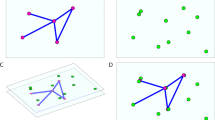Abstract
Mashups are gaining popularity as a rapid-development, re-use-oriented programming model to replace monolithic, bottom-up application development. This programming style is attractive for the “long tail” of scientific data management applications, characterized by exploding data volumes, increasing requirements for data sharing and collaboration, but limited software engineering budgets.
We observe that scientists already routinely construct a primitive, static form of mashup—an ensemble of related visualizations that convey a specific scientific message encoded as, e.g., a Powerpoint slide. Inspired by their ubiquity, we adopt these conventional data-product ensembles as a core model, endow them with interactivity, publish them online, and allow them to be repurposed at runtime by non-programmers.
We observe that these scientific mashups must accommodate a wider audience than commerce-oriented and entertainment-oriented mashups. Collaborators, students (K12 through graduate), the public, and policy makers are all potential consumers, but each group has a different level of domain sophistication. We explore techniques for adapting one mashup for different audiences by attaching additional context, assigning defaults, and re-skinning component products.
Existing mashup frameworks (and scientific workflow systems) emphasize an expressive “boxes-and-arrows” abstraction suitable for engineering individual products but overlook requirements for organizing products into synchronized ensembles or repurposing them for different audiences.
In this paper, we articulate these requirements for scientific mashups, describe an architecture for composing mashups as interactive, reconfigurable, web-based, visualization-oriented data product ensembles, and report on an initial implementation in use at an Ocean Observatory.
Preview
Unable to display preview. Download preview PDF.
Similar content being viewed by others
References
Barga, R., Jackson, J., Araujo, N., Guo, D., Gautam, N., Grochow, K., Lazowska, E.: Trident: Scientific Workflow Workbench for Oceanography. In: IEEE Congress on Services, pp. 465–466. IEEE Computer Society, Los Alamitos (2008)
CrimeMapping (2008), http://www.crimemapping.com/
Deelman, E., Singh, G., Su, M.H., Blythe, J., Gil, Y., Kesselman, C., Mehta, G., Vahi, K., Berriman, G.B., Good, J., Laity, A., Jacob, J.C., Katz, D.S.: Pegasus: a Framework for Mapping Complex Scientific Workflows onto Distributed Systems. Scientific Programming Journal 13(3), 219–237 (2005)
Gray, J., Szalay, A.S.: Where the Rubber Meets the Sky: Bridging the Gap between Databases and Science. IEEE Data Eng. Bull. 27(4), 3–11 (2004)
Hill, D.J., Minsker, B., Liu, Y., Myers, J.: End-to-End Cyberinfrastructure for Real-Time Environmental Decision Support. In: IEEE eScience (2008)
JackBe, http://www.jackbe.com
Jhingran, A.: Enterprise Information Mashups: Integrating Information, Simply. In: 32nd International Conference on Very Large Data Bases (2006)
The Kepler Project, http://kepler-project.org
Marini, L., Kooper, R., Bajcsy, P., Myers, J.D.: Publishing Active Workflows to Problem-Focused Web Spaces. In: IEEE eScience (2008)
The Matplotlib Library, http://matplotlib.sourceforge.net
Mint.com, http://mint.com
Microsoft Popfly, http://www.popfly.com
Collaborative Research on Oregon Ocean Salmon project (ProjectCROOS), http://projectcroos.com
Silva, C.: VisTrail, personal communication (2008)
SnapTweet, http://snaptweet.com/
The Taverna Project, http://taverna.sourceforge.net
TurboTax, http://turbotax.intuit.com
The VisTrails Project, http://www.vistrails.org
Santos, E., Freire, J., Silva, C.: Using Workflow Medleys to Streamline Exploratory Tasks, http://www.research.ibm.com/gvss/2007/presentations/emanuele_ibm_gvss2007.pdf
Yahoo Pipes, http://pipes.yahoo.com/pipes
Zhang, Y.L., Baptista, A.M.: SELFE: A semi-implicit Eulerian-Lagrangian finite-element model for cross-scale ocean circulation. Ocean Modelling 21(3-4), 71–96 (2008)
Author information
Authors and Affiliations
Editor information
Editors and Affiliations
Rights and permissions
Copyright information
© 2009 Springer-Verlag Berlin Heidelberg
About this paper
Cite this paper
Howe, B., Green-Fishback, H., Maier, D. (2009). Scientific Mashups: Runtime-Configurable Data Product Ensembles. In: Winslett, M. (eds) Scientific and Statistical Database Management. SSDBM 2009. Lecture Notes in Computer Science, vol 5566. Springer, Berlin, Heidelberg. https://doi.org/10.1007/978-3-642-02279-1_3
Download citation
DOI: https://doi.org/10.1007/978-3-642-02279-1_3
Publisher Name: Springer, Berlin, Heidelberg
Print ISBN: 978-3-642-02278-4
Online ISBN: 978-3-642-02279-1
eBook Packages: Computer ScienceComputer Science (R0)




